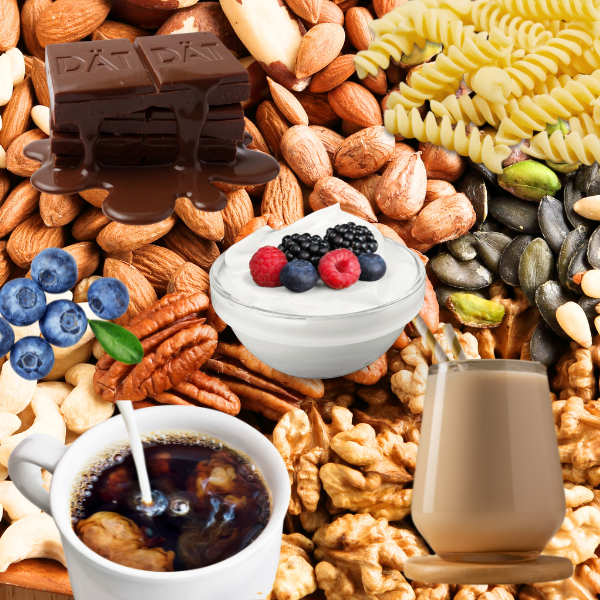6 Simple Food Swaps That Will Transform Your Energy and Digestion
Are you tired of that afternoon energy crash? Fed up with feeling bloated and sluggish after meals? You're not alone. Millions of people struggle with low energy and digestive issues, often without realizing that the solution might be simpler than they think.
Here's the truth: you don't need a complicated meal plan, expensive supplements, or a complete lifestyle overhaul to start feeling better. Most of the time, it's about making small, strategic choices—choosing foods with fewer ingredients and more nutrients like these.
The power of simple food swaps lies in their accessibility. Unlike dramatic diet changes that require willpower and often fail within weeks, small swaps integrate seamlessly into your existing routine. They work because they don't feel like deprivation; they feel like upgrades.
Why Small Changes Create Big Results
Before we dive into the specific swaps, it's important to understand why this approach is so effective. When you consistently choose whole foods over processed ones, several things happen in your body:
Your blood sugar stabilizes. Processed foods often contain hidden sugars and refined carbohydrates that cause rapid spikes and crashes in blood glucose. Whole foods, rich in fiber and nutrients, provide steady energy throughout the day.
Your digestive system functions better. Real foods contain the enzymes, fiber, and nutrients your gut needs to process food efficiently. This means less bloating, better nutrient absorption, and improved overall digestive health.
Your energy becomes more consistent. When you're not dealing with sugar crashes and digestive distress, your natural energy levels can shine through.
The beauty is that these benefits compound over time. Each healthy swap you make supports the others, creating a positive cycle that becomes easier to maintain.
The 6 Game-Changing Swaps
1. Coffee Creamer → Unsweetened Almond or Coconut Milk
Why this matters: Most commercial coffee creamers are loaded with corn syrup, artificial flavors, and hydrogenated oils—ingredients that can trigger inflammation and energy crashes. Some contain up to 5 grams of sugar per tablespoon, and let's be honest, who uses just one tablespoon?
The upgrade: Unsweetened almond milk or coconut milk provides the creamy texture you crave without the sugar overload. Coconut milk adds healthy medium-chain triglycerides (MCTs) that can actually boost your metabolism, while almond milk offers vitamin E and calcium.
Pro tip: If you're missing the sweetness, add a dash of cinnamon or vanilla extract. Both add flavor without spiking your blood sugar.
2. Pretzels → Raw Nuts or Seeds
Why this matters: Pretzels might seem like a "healthier" snack option, but they're essentially refined flour and salt. They provide quick energy followed by an inevitable crash, leaving you hungrier than before you started snacking.
The upgrade: Raw nuts and seeds offer the satisfying crunch you're looking for, plus protein, healthy fats, and fiber. This combination keeps you fuller longer and provides steady energy. Almonds, walnuts, pumpkin seeds, and sunflower seeds are all excellent choices.
The science: The protein and healthy fats in nuts help slow the absorption of any natural sugars, preventing blood sugar spikes. Studies have shown that people who eat nuts regularly have better weight management and lower rates of heart disease.
3. White Pasta → Lentil or Chickpea Pasta
Why this matters: White pasta is made from refined wheat flour, which has been stripped of most nutrients and fiber. It digests quickly, causing blood sugar spikes and leaving you hungry shortly after eating.
The upgrade: Lentil and chickpea pastas aren't just trendy—they're nutritional powerhouses. A single serving provides 15-20 grams of protein and 8-12 grams of fiber, compared to white pasta's measly 2 grams of fiber and 7 grams of protein.
Taste test: Modern legume-based pastas have come a long way. They have a hearty, satisfying texture that actually holds sauce better than traditional pasta. Red lentil pasta has a slightly sweet, nutty flavor, while chickpea pasta is more neutral.
4. Flavored Yogurt → Plain Greek Yogurt + Fresh Berries
Why this matters: Flavored yogurts often contain as much sugar as a candy bar—sometimes 20+ grams per container. This sugar not only contributes to energy crashes but can also disrupt the beneficial bacteria in your gut.
The upgrade: Plain Greek yogurt contains twice the protein of regular yogurt and significantly more probiotics. When you add your own fresh berries, you get natural sweetness plus antioxidants, fiber, and vitamins.
Beyond berries: add chopped nuts, or a sprinkle of chia seeds for extra nutrition and flavor variety or try our date-sweetened grain-free granola!
5. "Healthy" Sugar-Filled Chocolate → Date-Sweetened Options
Why this matters: Many products marketed as "healthy" chocolate or protein bars contain just as much sugar as conventional candy bars, often in the form of agave, brown rice syrup, or cane sugar. These still impact your blood sugar and energy levels.
The upgrade: Products sweetened only with dates provide the sweetness you crave along with fiber, potassium, and antioxidants. The fiber in dates helps slow sugar absorption, preventing the rapid blood sugar spikes associated with refined sweeteners.
What to look for: Choose bars like our DÄT Chocolate sweetened wit dates with short ingredient lists featuring whole foods you recognize. Dates should be the only sweetener listed.
6. Mystery-Ingredient Protein Shakes → Clean Protein Powder
Why this matters: Many protein powders contain artificial sweeteners like sucralose or stevia, gums and fillers that can cause digestive issues, and artificial flavors that may trigger sensitivities.
The upgrade: Look for clean protein powders with minimal ingredients—ideally just protein sources you recognize. A blend that includes both plant and animal proteins (when appropriate for your diet) can provide a complete amino acid profile.
Digestive benefits: Clean proteins without artificial additives are easier on your digestive system, reducing bloating and discomfort that many people associate with protein supplements. Need options? Try our Date-Sweetened Protein Powder + Collagen Blend made with the cleanest ingredients!
Making the Transition Sustainable
The key to making these swaps stick isn't willpower—it's strategy:
Start with one swap at a time. Choose the swap that feels easiest or most appealing to you and focus on that for 1-2 weeks before adding another.
Stock your environment. Keep the healthy alternatives readily available. Put nuts in your car, keep coconut milk in your fridge, and store chickpea pasta in your pantry.
Prepare for the adjustment period. Your taste buds may need time to adapt, especially if you're used to very sweet or salty processed foods. Give yourself at least a week to adjust to each new food.
Focus on how you feel. Pay attention to your energy levels, digestion, and overall well-being. These positive changes will motivate you to continue.
The Ripple Effect
These swaps aren't just about individual foods—they're about shifting your entire relationship with eating. When you choose whole foods over processed ones, you start to notice:
- More stable energy throughout the day
- Better sleep quality
- Improved mood and mental clarity
- Reduced cravings for junk food
- Better digestive health
The great thing about this approach is that it's not about perfection. It's about progress. Every swap you make is a step toward feeling better, and the more you trade processed for whole, the better your body and mind will thank you.
Your Next Step
Ready to start feeling the difference? Pick one swap from this list and commit to trying it for the next week. Notice how your body responds, and then gradually add more swaps as you feel ready.
Remember, sustainable change happens one choice at a time. These simple swaps might seem small, but their impact on your energy and digestion can be transformational. Your future self will thank you for starting today.
 Recipes
Recipes











